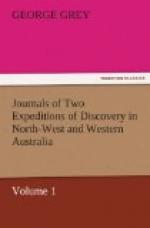Caught also shells and crabs of the same kind as yesterday.
November 14. Latitude 29 degrees 26 minutes south; longitude 101 degrees 2 minutes east.
Physsophora rosacea, Cuvier, see below. We caught another animal of the same kind as the one taken on the 12th of November, and figured in Illustration 7. It was so delicate that I did not measure it for fear of its falling to pieces, but it appeared to be exactly the same size as the former one.
Its circle of large tentacula were of a bright pink, and were fifteen in number; inside this circle was a smaller one of the same number of shorter tentacula, which were not quite so bright a pink colour; in the centre of these were placed organs of a very extraordinary nature, apparently quite round, and not thicker than the very finest silk; they were arranged exactly in the form of a corkscrew, and from the beauty of their mechanism, the animal could press fold against fold, and thus render them less than a quarter of an inch in length, and I watched it almost instantaneously expand them to the length of nine inches. After having observed the animal closely for an hour I am writing this with it before me, alive in a large glass bottle of salt water, and measuring what I put down. The manner in which it expands these organs is by first uncoiling those folds nearest the body, and afterwards those most remote; so that when folded up it looks like a corkscrew with the folds pressed close together, and when expanded, like a long straight thin bit of flesh-coloured silk, with a little corkscrew of the same material at the end. The larger tentacula are shaped like the trunk of an elephant, and their extremity is furnished with a very delicate organ with which they can catch anything, and, if touched, they instantly turn some of these tentacula, which they have the power of moving in any direction, to the point so touched. They are not electrical: the lateral bags have a slight tinge of a bright amber colour. These animals sustain themselves in the water by means of the little bag marked (a) in the figure, which floats on the surface full of air, they there swim in the manner before described. I afterwards observed very minute globules, or lumps, in the long silk-like tentacula. When expanded these were very distinct.
Latitude 29 degrees 26 minutes south; longitude 101 degrees 32 minutes east.
We caught several small shells (Janthina exigua) this afternoon: Illustration 9 represents one of them, with the string of air bubbles attached, by means of which they swim on the water. They appear not to be able to free themselves from this mass of bubbles: every shell I have yet found floating in the Indian Ocean possesses these bubbles in a greater or less degree; they were of a purple colour. I have seen the common garden snail in England emit a nearly similar consistency: they also emit a blue or purple liquid, which colours anything it touches.




